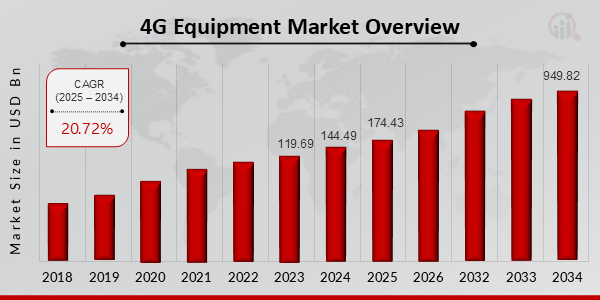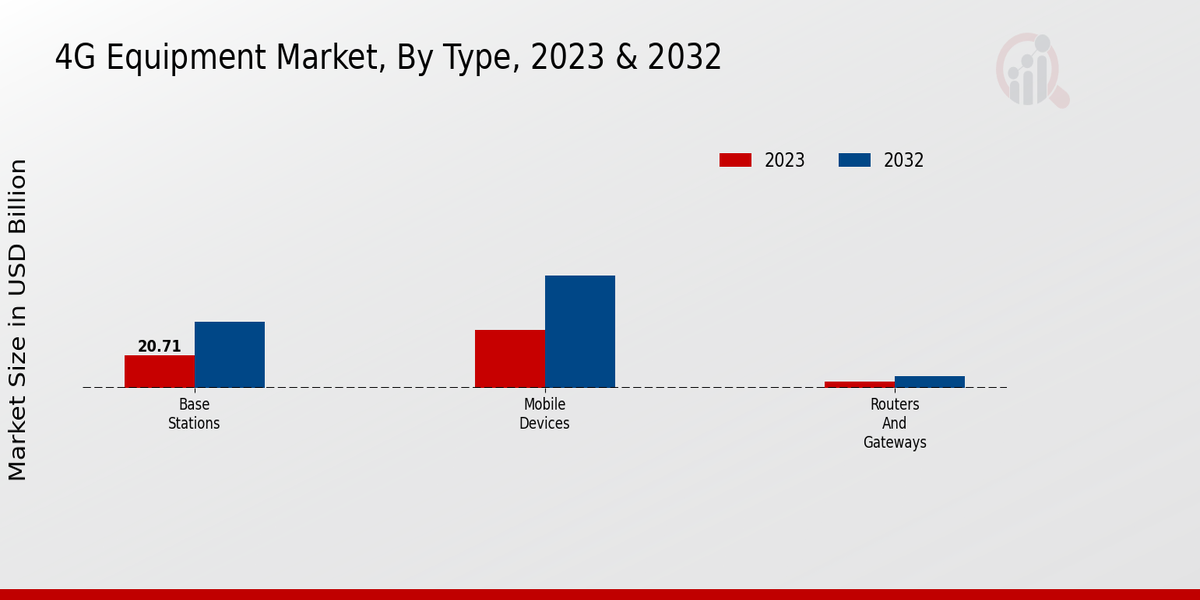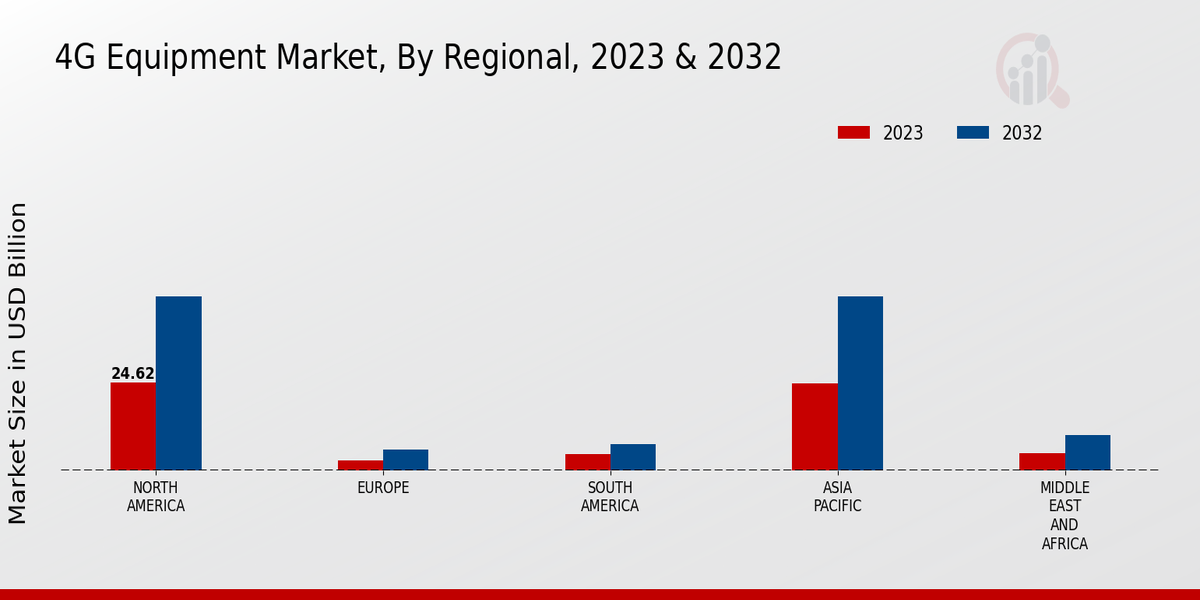4G Equipment Market Overview
4G Equipment Market is projected to grow from USD 174.43 Billion in 2025 to USD 949.82 Billion by 2034, exhibiting a compound annual growth rate (CAGR) of 20.72% during the forecast period (2025 - 2034).
Additionally, the market size for 4G Equipment Market was valued at USD 144.49 billion in 2024.
Key 4G Equipment Market Trends Highlighted
The 4G equipment market is influenced by several key market drivers, including the increasing demand for mobile data traffic, the need for higher network capacity, and the deployment of advanced technologies such as LTE-Advanced and LTE-Advanced Pro. Emerging opportunities in the market include the growth of mobile broadband, the expansion of IoT devices, and the development of new applications. Significant trends in recent times include the integration of cloud-based technologies into 4G networks, the adoption of software-defined networking (SDN) and network function virtualization (NFV), and the convergence of fixed and mobile networks. 4G equipment is also being deployed in rural and remote areas to bridge the digital divide.
Figure 1: 4G Equipment Market size 2025-2034

Source: Primary Research, Secondary Research, MRFR Database and Analyst Review
4G Equipment Market Drivers
Growing Demand for Enhanced Mobile Broadband Services
The increasing demand for enhanced mobile broadband services is a major driver of the 4G Equipment Market Industry. The proliferation of smartphones, tablets, and other mobile devices has led to a surge in data traffic, which is driving the need for faster and more reliable wireless networks. 4G technology offers significantly faster data speeds and lower latency than previous generations of wireless technology, making it ideal for a variety of applications, including video streaming, gaming, and social networking.As a result, mobile network operators are investing heavily in 4G network infrastructure to meet the growing demand for these services.
Government Initiatives to Promote Broadband Connectivity
Government initiatives to promote broadband connectivity are another key driver of the 4G Equipment Market Industry. Governments around the world are recognizing the importance of broadband connectivity for economic development and social progress. As a result, they are implementing a variety of policies and programs to encourage the deployment of broadband networks, including 4G networks. These initiatives are helping to create a more favorable environment for investment in 4G equipment, which is driving the growth of the market.
Technological Advancements and Innovation
Technological advancements and innovation are also driving the growth of the 4G Equipment Market Industry. The development of new 4G technologies, such as LTE-Advanced and LTE-Advanced Pro, is enabling mobile network operators to offer even faster data speeds and lower latency. Additionally, the development of new antenna technologies and other network optimization techniques is helping to improve the performance and efficiency of 4G networks.These advancements are making 4G technology more attractive to mobile network operators and end-users, which is driving the growth of the market.
4G Equipment Market Segment Insights
4G Equipment Market Type Insights
The 4G Equipment Market is segmented by Type into Base Stations, Mobile Devices, Routers and Gateways. Base Stations segment held the largest market share of 49.5% in 2023 and is expected to continue its dominance throughout the forecast period. This can be attributed to the increasing deployment of 4G base stations to meet the growing demand for high-speed mobile broadband services. The Mobile Devices segment is expected to witness a significant growth rate during the forecast period. The growing adoption of smartphones and tablets, coupled with the increasing availability of affordable 4G-enabled devices, is driving the growth of this segment.
The routers and Gateways segment is expected to grow at a steady pace during the forecast period. The increasing demand for high-speed mobile broadband services, the growing adoption of 4G-enabled devices, and the expansion of 4G networks are the key factors driving the growth of the 4G Equipment Market.
Figure 2: 4G Equipment Market By Condition, 2023 & 2032

Source: Primary Research, Secondary Research, MRFR Database and Analyst Review
4G Equipment Market Frequency Band Insights
The Frequency Band segment plays a crucial role in the 4G Equipment Market. Among the various frequency bands analyzed, LTE Band 7, LTE Band 20, LTE Band 28, LTE Band 40, LTE Band 41, LTE Band 42, LTE Band 66 and LTE Band 71 are expected to propel market growth. These bands provide enhanced coverage, improved data speeds, and increased network capacity. The 4G Equipment Market revenue for the Frequency Band segment is projected to reach 60.86 billion USD in 2023, with a CAGR of 7.84%. This growth is driven by the increasing demand for high-speed mobile data services, expansion of 4G networks and adoption of advanced technologies such as MIMO and carrier aggregation.
4G Equipment Market Technology Insights
The 4G Equipment Market segmentation by technology includes MIMO, OFDMA, and SC-FDMA. MIMO technology dominated the market in 2023, accounting for over 60% of the 4G Equipment Market revenue. OFDMA is expected to experience significant growth over the forecast period, owing to its ability to improve spectral efficiency and reduce latency. SC-FDMA is also expected to gain traction due to its low power consumption and cost-effectiveness. The growth of the market is attributed to the increasing demand for high-speed internet connectivity, the rising adoption of smartphones and tablets, and the expansion of mobile broadband networks.
4G Equipment Market Deployment Model Insights
The 4G Equipment Market is segmented based on the Deployment Model into Macro Cells, Small Cells, and Distributed Antenna Systems (DAS). The Macro Cells segment held the largest market share in 2023, accounting for over 60% of the 4G Equipment Market revenue. Growth of this segment can be attributed to the increasing demand for high-speed and reliable wireless connectivity in urban areas. The small Cells segment is expected to grow at a significant CAGR during the forecast period, owing to the increasing adoption of small cells in rural and suburban areas.
Distributed Antenna Systems (DAS) segment is also expected to witness significant growth due to increasing deployment of DAS in public venues such as airports, stadiums and shopping malls.
4G Equipment Market Application Insights
The 4G Equipment Market is segmented by application into Mobile Broadband, Fixed Wireless Access (FWA), Enterprise Services and Internet of Things (IoT). Mobile Broadband segment is expected to hold the largest share of the market in 2023 due to increasing demand for high-speed mobile internet access. FWA segment is expected to grow at the highest CAGR, during the forecast period due to the increasing popularity of fixed wireless broadband services. The Enterprise Services segment is expected to account for a significant share of the market in 2023, due to increasing demand for 4G-based enterprise applications.
The IoT segment is expected to grow rapidly during the forecast period due to the increasing adoption of IoT devices and applications.
4G Equipment Market Regional Insights
The 4G Equipment Market is segmented into North America, Europe, APAC, South America, and MEA. North America holds the largest market share due to the presence of major telecom operators and early adoption of 4G technology. Europe is the second-largest market, followed by APAC. APAC is expected to grow at the highest CAGR during the forecast period due to the increasing demand for mobile broadband services and government initiatives to improve network infrastructure. South America and MEA are expected to witness moderate growth due to the limited availability of spectrum and infrastructure challenges.
The growth of the market is attributed to the increasing demand for mobile broadband services, the deployment of 4G networks in rural areas, and the growing adoption of IoT devices.
Figure 3: 4G Equipment Market By Regional, 2023 & 2032

Source: Primary Research, Secondary Research, MRFR Database and Analyst Review
4G Equipment Market Key Players And Competitive Insights
Major players in the 4G Equipment Market industry are continuously striving to stay ahead of the competition by introducing new and innovative products, forming strategic partnerships, and expanding their geographical reach. Leading 4G Equipment Market players are investing mostly in research and development activities to create more advanced and efficient technologies. The 4G Equipment Market development landscape is characterized by intense competition, with established players and emerging companies vying for market share. The competitive landscape of the 4G Equipment Market is shaped by factors such as technological advancements, pricing strategies, distribution channels, and the overall economic environment. To maintain their position in the market, leading 4G Equipment Market players are focusing on enhancing their product offerings, optimizing their supply chains, and strengthening their customer relationships.
Nokia, a leading name in the telecommunications industry, is known for providing innovative 4G equipment solutions. The company has a vast portfolio of 4G products, including base stations, antennas, and core network elements. Nokia's 4G equipment is designed to provide high-speed connectivity, low latency, and improved network capacity. The company has a strong presence in both developed and developing markets, and it continues to invest in research and development to maintain its competitive edge.
Ericsson, another major player in the 4G Equipment Market, is recognized for its advanced 4G technologies and presence. The company offers a comprehensive range of 4G products and solutions, including radio access networks, core network solutions, and managed services. Ericsson's 4G equipment is deployed in over 180 countries, and it plays a significant role in enabling mobile broadband connectivity worldwide. The company's focus on innovation and customer-centric approach has contributed to its strong position in the 4G Equipment Market.
Key Companies in the 4G Equipment Market Include
-
Huawei Technologies Co., Ltd.
-
Ericsson
-
Samsung Electronics Co., Ltd.
-
TE Connectivity
-
ZTE Corporation
-
Nokia
-
Fujitsu Limited
-
CommScope
-
Cisco Systems, Inc.
-
Hitachi, Ltd.
-
NEC Corporation
-
Harmonic Inc.
-
Anritsu
-
Keysight Technologies
-
Alcatel-Lucent
4G Equipment Market Industry Developments
The 4G Equipment Market is projected to experience steady growth over the forecast period, driven by increasing demand for high-speed mobile internet, expanding 4G network infrastructure, and rising adoption of smartphones. The market is expected to reach a valuation of USD 60.86 billion by 2023 and is anticipated to expand further to USD 120.0 billion by 2032, exhibiting a CAGR of 7.84%.
Recent news developments include the launch of 5G-ready 4G equipment by major vendors such as Ericsson, Nokia, and Huawei. These advancements are expected to cater to the growing need for faster and more reliable mobile connectivity. Additionally, government initiatives to expand 4G coverage in rural and underserved areas are expected to drive market growth.
4G Equipment Market Segmentation Insights
- 4G Equipment Market Type Outlook
- Base Stations
- Mobile Devices
- Routers and Gateways
-
4G Equipment Market Frequency Band Outlook
-
LTE Band 7
-
LTE Band 20
-
LTE Band 28
-
LTE Band 40
-
LTE Band 41
-
LTE Band 42
-
LTE Band 66
-
LTE Band 71
-
4G Equipment Market Technology Outlook
-
4G Equipment Market Deployment Model Outlook
-
4G Equipment Market Application Outlook
-
4G Equipment Market Regional Outlook
-
North America
-
Europe
-
South America
-
Asia Pacific
-
Middle East and Africa
|
Report Attribute/Metric
|
Details
|
|
Market Size 2024
|
144.49 (USD Billion)
|
|
Market Size 2025
|
174.43 (USD Billion)
|
|
Market Size 2034
|
949.82 (USD Billion)
|
|
Compound Annual Growth Rate (CAGR)
|
20.72% (2025 - 2034)
|
|
Report Coverage
|
Revenue Forecast, Competitive Landscape, Growth Factors, and Trends
|
|
Base Year
|
2024
|
|
Market Forecast Period
|
2025 - 2034
|
|
Historical Data
|
2019 - 2023
|
|
Market Forecast Units
|
USD Billion
|
| Key Companies Profiled |
Huawei Technologies Co., Ltd., Ericsson, Samsung Electronics Co., Ltd., TE Connectivity, ZTE Corporation, Nokia, Fujitsu Limited, CommScope, Cisco Systems, Inc., Hitachi, Ltd., NEC Corporation, Harmonic Inc., Anritsu, Keysight Technologies, Alcatel-Lucent |
| Segments Covered |
Type, Frequency Band, Technology, Deployment Model, Application, Regional |
| Key Market Opportunities |
Expansion of 4G networks in emerging marketsGrowing demand for highspeed mobile internetIncreasing adoption of IoT devicesGovernment initiatives to improve connectivityTechnological advancements in 4G equipment |
| Key Market Dynamics |
Technological advancementsGrowing demand for highspeed internet accessIncreasing adoption of smartphones and tabletsExpanding LTE networksSpectrum availability and government regulations |
| Countries Covered |
North America, Europe, APAC, South America, MEA |
Frequently Asked Questions (FAQ) :
The 4G Equipment Market is expected to reach a valuation of USD 99.13 Billion by 2023, expanding to USD 949.82 Billion by 2034, exhibiting a 20.7% CAGR during the forecast period.
Asia Pacific is anticipated to dominate the 4G Equipment Market, attributed to the increasing adoption of 4G technology and the presence of developing economies such as India and China. North America and Europe are also significant markets for 4G equipment due to the presence of established telecommunication infrastructure and high demand for mobile broadband services.
4G Equipment finds applications in various sectors, including smartphones, tablets, mobile hotspots, and fixed wireless access devices. The increasing penetration of smartphones and the growing demand for high-speed mobile internet connectivity are the primary factors driving the adoption of 4G Equipment.
The 4G Equipment Market is highly competitive, with several established players. Some of the key competitors include Huawei, Ericsson, Nokia, ZTE, and Samsung. These companies offer a wide range of 4G Equipment, including base stations, routers, and modems.
The increasing demand for mobile broadband services, the proliferation of smartphones, and the expansion of 4G network infrastructure are some of the key trends driving the growth of the 4G Equipment Market. Additionally, government initiatives to improve connectivity in rural and underserved areas are also contributing to the market's growth.
The emergence of 5G technology is expected to have a significant impact on the 4G Equipment Market. As 5G networks are deployed, the demand for 4G Equipment is likely to decline. However, 4G Equipment is expected to remain in use for several years, particularly in regions with limited 5G coverage or where 5G devices are not widely adopted.
The 4G Equipment Market faces several challenges, including intense competition, technological advancements, and regulatory changes. Additionally, the availability of low-cost alternatives and the saturation of the 4G market in developed economies are also factors that could hinder the market's growth.
The 4G Equipment Market is expected to witness steady growth over the coming years. The increasing adoption of 4G technology in emerging markets and the ongoing expansion of 4G networks are factors that will continue to drive the market's growth. However, the emergence of 5G technology and the decline in demand for 4G Equipment in developed economies are factors that could limit the market's growth potential.
The Asia Pacific 4G Equipment Market is driven by several factors, including the increasing adoption of 4G technology, the presence of developing economies with large populations, and government initiatives to improve connectivity. Additionally, the growing demand for smartphones and mobile broadband services is also contributing to the market's growth.
The North American 4G Equipment Market faces challenges such as intense competition, the saturation of the 4G market, and the availability of low-cost alternatives. Additionally, the emergence of 5G technology and the decline in demand for 4G Equipment are factors that could hinder the market's growth.

















